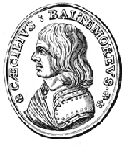|
|
|
|
|
ROADS IN CECIL COUNTY,
1700-1762
by: Pat Melville
As with previous counties, information about roads in
Cecil County appears as short entries in the court
minutes, as recorded in (Judgment Record) in series C623.
The series contains the administrative and judicial
minutes and the recorded criminal and civil proceedings of
the county court. The series dates from 1683, but minutes
are not extant until 1700. After that, there are several
short periods of time for which no judgments or minutes
exist, and some record books contain judgments but no
minutes.
The first road entry in 1700 authorized a toll for riding
or leading a horse over the bridge between the courthouse
and Thomas Keltor's. Another entry listed the overseers of
the roads and geographic areas of responsibility: Hermanus
Shees for the lower part of Worton Hundred and James
Barber for the upper part, John James for the lower part
of South Sassafras Hundred and James Wilson for the upper
part, Thomas Therson for the upper part of North Sassafras
Hundred and Thomas Cox for the lower part, Alexander
Camble for the road from his house to Bohemia ferry to
Bartlett's, Richard Franklin for the road from Back Creek
to Kerseys Run to New Castle Road, Thomas Yeaman for the
road from Kerseys Run to Susquehanna ferry, and Samson
George for the road from Susquehanna Road to Turkey Point
to the head of North East River.
The county justices appointed overseers annually and
filled vacancies as they occurred. Sometimes the annual
appointment record contained the names of the new
officials with a notation that the rest were continued in
office. In other instances, the minutes included a full
roster of overseers accompanied by a list of all the
public roads, or the areas of concern expressed as parts
of hundreds, or a combination of the two, as done in 1700.
By 1759, the number of overseers had reached 41, a figure
that grew to 45 a year later.
|
|
|
|
|
|
|
|
|
|
By law, the county court was required to ascertain
annually the roads deemed public facilities. If the judges
performed this duty every year, the clerk did not
faithfully record the lists. A sampling of the minutes
revealed complete lists of roads in 1710, 1759, and 1760.
The 1710 list described most roads as going from one point
to another. Using Bohemia Ferry as the focal point,
examples include courthouse to the ferry, ferry to
Franklins Point, ferry to Broxsons by way of White Marsh
and Harris mill, from ferry to head of Bohemia via John
Rauington's, ferry to head of Back Creek where Hance
Marcus once lived, and ferry to Elk ferry.
The roads listed in 1759 provided more geographic
points of reference, even if today some of them are not
readily meaningful.
-
Pearces Neck to St. Stephens Church and Pearces Neck
to Bohemia Ferry,
-
Lower road on Bohemia Manor from Benjamin Moody's
plantation along Burkles Ridge east to the upper road
that leads over the head of Bohemia River,
-
Nelsons Mill to Peach Bottom,
-
Horse Head, or Spencers, Road from Little Elk River
to Samuel Gilpin's mill on a branch of North East
River, and
-
Elk Ferry to Doffeys Point on North East River, as
follows: from upper end of James Veazey's plantation
west northwest to the corner stone of Veazey's land,
northwest to Quits Mountain, and south to North East
River.
Residents could file petitions concerning road matters,
such as opening new ones, changing routes, and building
bridges. In 1716, the court ordered Henry Ramsey to
clear the old Reden
Island Road as far as the old bridge. In 1723, several
citizens requested a road from the head of Elk to New
Castle and Christine Bridge to replace existing
nonpublic routes that were subject to blockages
|
|
|
|
|





